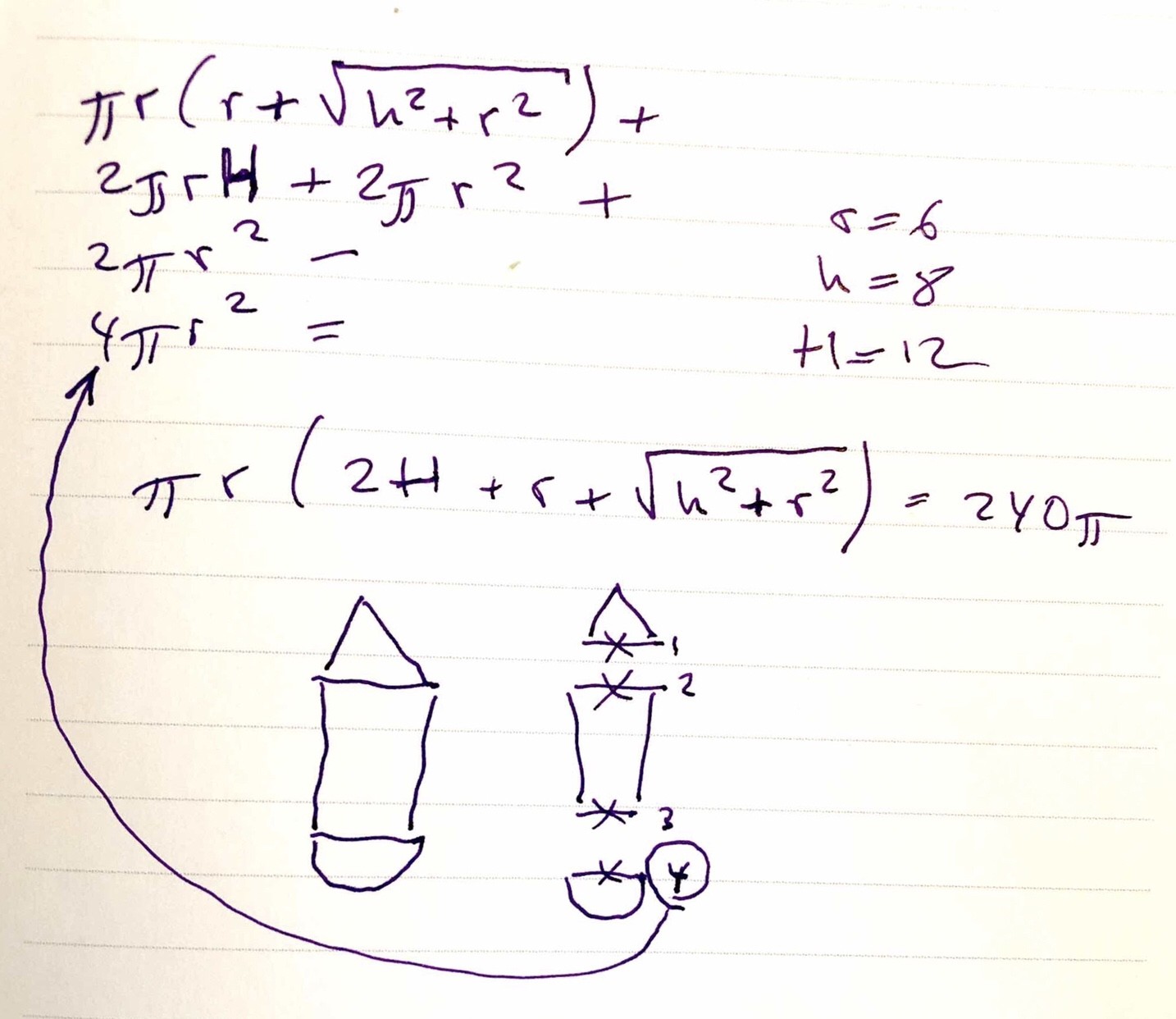Originally published February 9, 2018 @ 10:32 pm
To make this long (and embarrassing) story short: a friend’s kid had a homework assignment in geometry to calculate the surface area of a conjoined cone, a cylinder, and a hemisphere.
Geometry being the only subject in which I never had anything less than perfect marks, I decided to help out and take a crack at this most basic of problems. And got it wrong. And argued about it. And then summoned my long-abandoned Mathematica programming skills and a dusty laptop that still had the damned thing installed. And the results confirmed my initial solution, and so I argued some more. But I was still wrong.

If you work with computers, you probably know how quickly shell command syntax displaces any real-world knowledge in your brain (unless you’re a Windows admin, in which case you don’t. Sorry about that). The shortest path to a solution, in my estimation, was to break the problem down to its three constituents: the cone, the cylinder, and the hemisphere; calculate the surface area of each separately; add them together; and, finally, subtract the four joining elements – the bases: one for the cone, two for the cylinder, and one for the hemisphere.

This was a perfectly valid approach. Not the most efficient, but very logical for a “computer guy”. The end result of these uncomplicated calculations turned out to be exactly Pi*r^2 less than the textbook’s answer to the problem. The textbook must be wrong! This happened to me a couple of times and the feeling you get from proving wrong your teacher, the PhDs who authored the textbook, and, indeed, the entire Soviet Ministry of Education (yes, it’s been a while) is best characterized as indescribable joy.
Unfortunately for me, the problem involved the most mysterious and otherworldly shape in all of geometry: the hemisphere. When you calculate the surface area of a cone, a cylinder, and just about any other three-dimensional geometrical shape, the calculations include all of the sides. Of course, they do – it’s surface area – it makes sense! Not so for a hemisphere. Apparently, the base of a hemisphere is surface-area-less. It doesn’t exist. Any geometry textbook will tell you that the surface area of a sphere is 4*Pi*r^2 and, therefore, the surface area of a hemisphere is exactly half that. But doesn’t this make a hemisphere an impossible object in three dimensions? Think about this: it has one side as if it still was a sphere. Like some googly Möbius strip.
If you were to imagine a hollow hemisphere with wall thickness approaching zero, it’s surface area would be approaching that of a complete sphere: 2*Pi*r^2 for the outie and one more of those for the innie. On the other hand, if you think of a hemisphere as half of a perfectly round watermelon (and that’s exactly how one should think about it – a sweet, thirst-quenching, satisfying watermelon), then the surface area would be that of the hemispherical dome and the circular base: 3*Pi*r^2. But, no, it’s 2*Pi*r^2 – the surface area of an impossible three-dimensional object. Why? Because “hemi” means “half” – end of discussion.
This is as if each hypothetical sphere contained a gravitational singularity, such that, when sawed in half, produced a dome-shaped protuberance on one side and on the other – a one-dimensional point of infinite space-time curvature. Thus we have a problem that’s more linguistic than geometrical. And the solution is simple: from now on and until the end of time a hemisphere shall be known as hemiwatermelon to prevent any astrophysics and relativistic mechanics from seeping into the neat and ancient world of geometry. There – problem solved. You’re welcome.

Experienced Unix/Linux System Administrator with 20-year background in Systems Analysis, Problem Resolution and Engineering Application Support in a large distributed Unix and Windows server environment. Strong problem determination skills. Good knowledge of networking, remote diagnostic techniques, firewalls and network security. Extensive experience with engineering application and database servers, high-availability systems, high-performance computing clusters, and process automation.






























